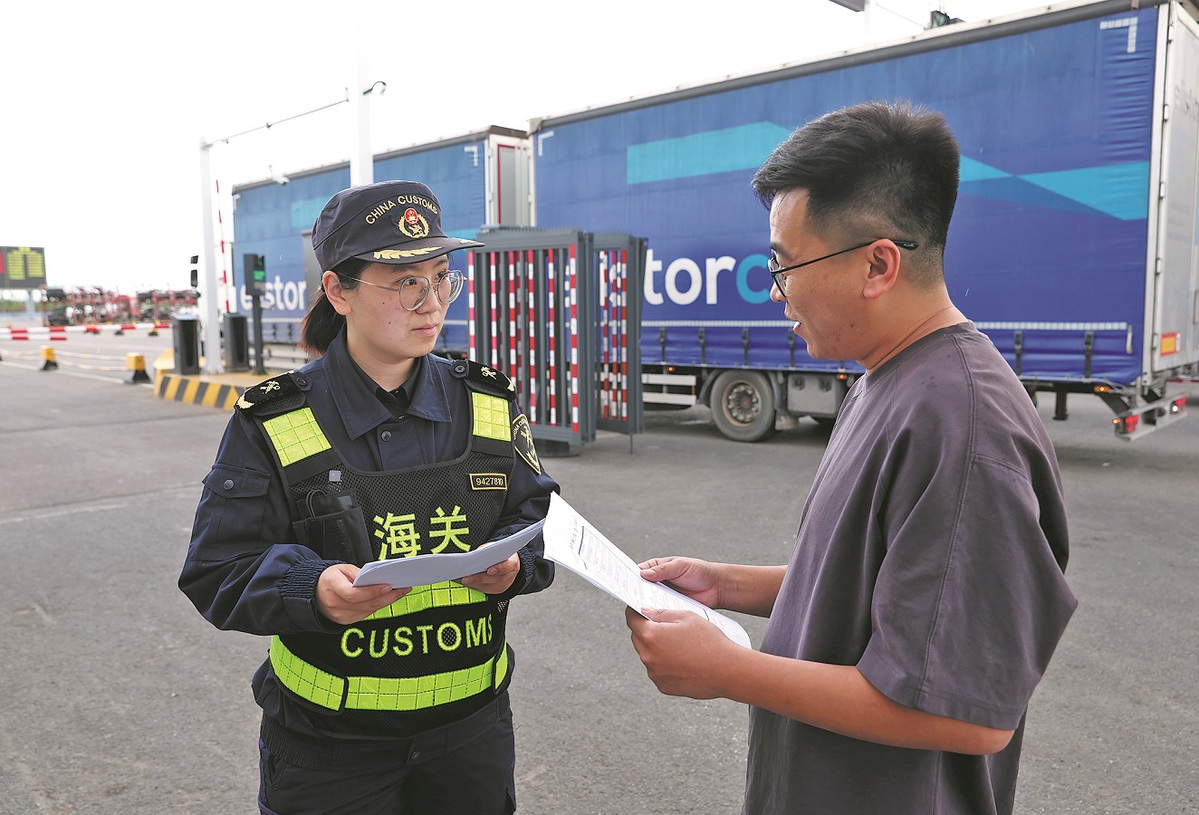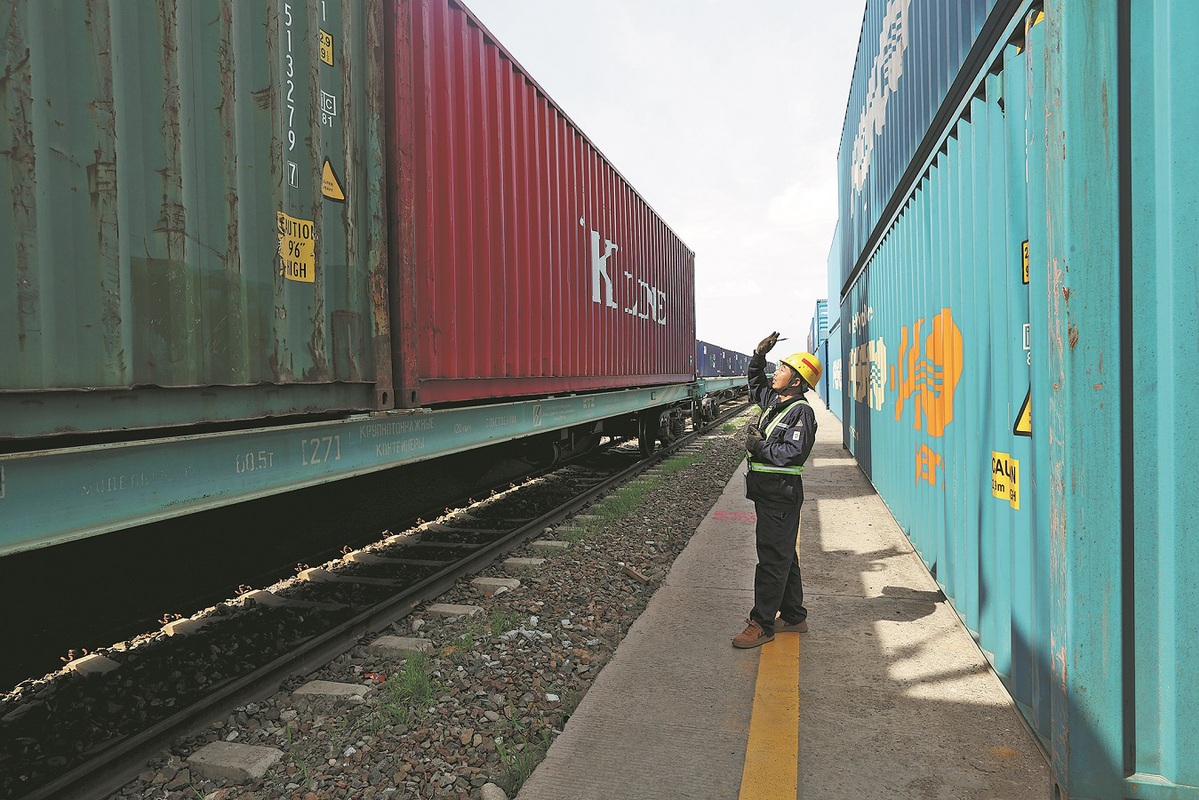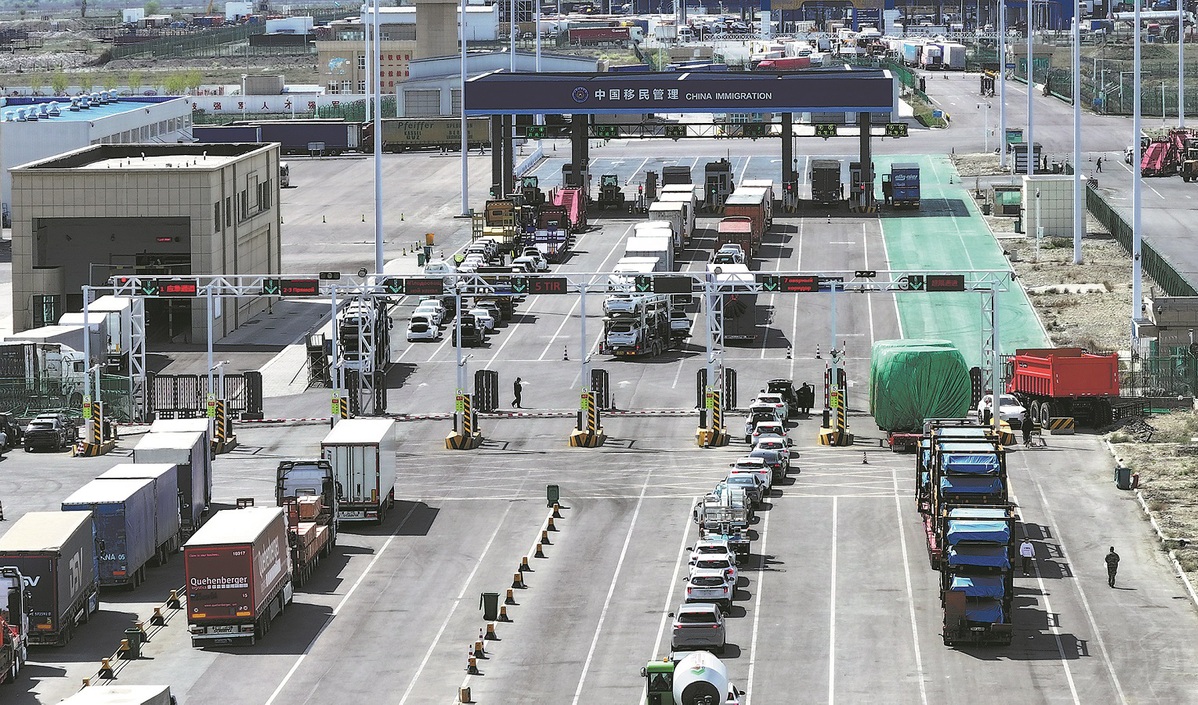
For Zhu Junwei, a logistics worker at the Horgos road port in the Xinjiang Uygur autonomous region on the border between China and Kazakhstan, the sight of Chinese-made cars waiting to be shipped to the Central Asian market has become commonplace.
"The traffic police are often on duty near the customs clearance compound to prevent traffic jams. This is how busy the Horgos land port is," said Zhu from Horgos Silurongteng Logistics, while handing in paperwork to export a batch of electric cars in late April.
The vehicles' customs clearance can be completed simply by scanning a QR code.
"The whole procedure for exporting goods via Horgos is as smooth as butter. It has become even easier since Horgos became a part of the China (Xinjiang) Pilot Free Trade Zone in 2023 as there's been even more streamlining of customs and security inspection procedures," Zhu said.
On Aug 14, 2023, Horgos, in Xinjiang's Ili Kazak autonomous prefecture, became the first road port in the region to trial 24/7 passage for traded goods. It means that customs and border inspection teams have to work more closely and be better coordinated around the clock to cut the inspection time.
Besides daily necessities, fruit and vegetables and electronics, new energy vehicles have become the latest Chinese products that have gained popularity in Central Asian markets, said Zhu, who added he had to return to the port in the evening to export another batch of EVs.
"We are quite busy. The customs and border inspection officers are busy. Everyone is busy at Horgos," he said.
Li Suting, an administrator at Horgos Customs, said with the growing number of domestically made vehicles being exported, a special lane for commercial vehicles has been running at the customs clearance compound since Sept 2 last year.
"We have to clear about 500 commercial vehicles every day," Li said. "Besides going through the special lane, they can also use the fast-track clearance service. Meanwhile, more than 600 vehicles carrying daily necessities and fruit and vegetables will go through the Horgos road port on a daily basis."
According to Horgos Customs, from January to March this year, 75,000 vehicles for export passed through Horgos, representing a year-on-year increase of 13.7 percent. After arriving in Kazakhstan, they are then sold in other Central Asian countries and Russia.
ALSO READ: China, Central Asia witness deepened economic, trade ties

With the Xinjiang pilot FTZ being established in November 2023, Horgos Customs has streamlined the import clearance process from nine steps to four, and the export clearance process from 12 steps to four through close coordination with customs and border inspection. The time it takes for a goods vehicle to go through customs clearance at the port has been reduced from two to three days, to just six hours, Li added.
"Thanks to the significant reduction in the export clearance process, the port clearance costs for businesses, including storage fees, handling fees, fees for regulatory warehouses and personnel costs, have been further reduced," Li said.
According to business estimates, each commercial vehicle can reduce its storage fees by at least 100 yuan ($13.85), and driver handling fees by 100 yuan. For heavy export vehicles, storage and handling costs can be reduced by 1,000 yuan per vehicle. Additionally, it is possible to reduce two or three field workers, administrative staff and other employees, with an expected cost reduction of at least 10,000 to 20,000 yuan per month, Horgos Customs said.
Horgos was once a busy passage used by traders traveling along the ancient Silk Road. As a border pass, it dates back more than 140 years. While it lost its shine after caravans faded into history, the Belt and Road Initiative, proposed by China in 2013, has revitalized the crossing.
Zhang Dongchang, a freight train dispatcher at Horgos railway station, has witnessed this progress firsthand.
Zhang has been working at the railway station since 2014. "Back then, I only needed to dispatch a pair of freight trains a day. But now the number has increased to about 22, so we have to work around the clock," he said, while monitoring the status of trains on a big screen.
So far, more than 45,000 freight trains operating on 85 routes have reached their destinations in 18 countries and 46 cities and regions in Central Asia and Europe via the Horgos railway port, making it an important logistics channel connecting China and Eurasia.
At 4 pm on April 23, a freight train of 55 containers, loaded with daily necessities, electronic devices and other goods, departed from Horgos and headed to Malaszewicze, Poland. It was the 3,000th China-Europe and China-Central Asia freight train to pass through Horgos this year. Rail freight through Horgos this year so far is up 28.7 percent year-on-year, Horgos Customs said.

Zhang said that the growing demand for Chinese products means that the number of freight trains and routes will only continue to increase.
Because of rail gauge differences between Kazakhstan and China, goods have to be switched at the border. Since the start of this year, the Horgos railway port has optimized platform capacity, production resources and personnel deployment to enhance the container-swapping of each freight train. The whole process can be completed within three hours.
ALSO READ: GBA's trade with Central Asia rises
"Efficiency and punctuality are key for the operation of China-Europe freight trains. Otherwise, businesses will choose to use sea shipping. So the railway, customs and border inspection authorities in Horgos often hold meetings to discuss how to make the trains passing the border faster even by a few minutes," Zhang said.
He added the long-planned China-Kyrgyzstan-Uzbekistan Railway is scheduled to begin construction later this year. The railway will start from southern Xinjiang's Kashgar and will open a new, shorter route between China and Europe.
"Currently, land transport between China and the two Central Asian nations relies on road-rail routes or must detour through Kazakhstan via ports including Horgos. Once operational, the railway will not only cut transport time, but also exempt goods from being unloaded and reloaded multiple times," Zhang said.
Guo Zhigui, manager of Tongjianggongchuang International Trade Company, said the company decided to set up a cross-border e-commerce platform in Horgos selling daily necessities at the end of last year because efforts to make the border city a hub for reform and opening-up have paid off.
"Horgos, which has a natural geographic advantage for opening-up, has been transformed since the BRI was introduced. With the boost in connectivity, trade facilitation and policy support, it has become an ideal place to set up businesses targeting Central Asian markets," Guo said at the company's office at the China-Kazakhstan Horgos International Border Cooperation Center.
Covering 5.6 square kilometers, with 3.43 sq km in the Chinese section and 2.17 sq km in the Kazakh section, the border cooperation center has been in operation since April 2012. It's the first cross-border cooperation zone established between China and another country.

Citizens of China, Kazakhstan and other countries can enter the center using valid documents such as passports or entry-exit permits, allowing them to engage in face-to-face negotiations, transactions, shopping and tourism without visas.
"Although people from Central Asian countries can directly place orders on our e-commerce platform, many people still prefer to see the products first. So we've set up a showroom at the border cooperation center that they can easily access. Old and new ways of doing business are both very convenient in Horgos, which is very inclusive," Guo said.
He added that the recent trade frictions between China and the United States have made people see the importance of having a smooth trade channel with Central Asian countries.
"While people are worried about the consequences of the frictions, it's business as usual here in Horgos. After laying solid foundations to facilitate trade with more countries involved in the BRI, businesses can easily seek opportunities and explore new markets elsewhere," Guo said.
In the first quarter of this year, Xinjiang's foreign trade value totaled 108.16 billion yuan, up 15.4 percent year-on-year. Trade with five Central Asian countries accounted for 52.7 percent of the region's total, according to Urumqi Customs.
READ MORE: Xinjiang sees rapid growth of foreign trade
The growth, mainly driven by strong export demand and diversification in trade partnerships, shows a promising start to the year amid a complex global trade environment, it said.


